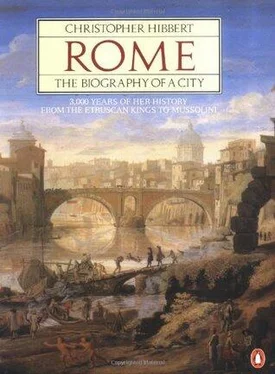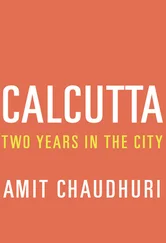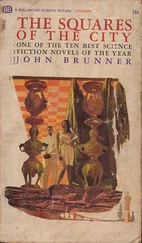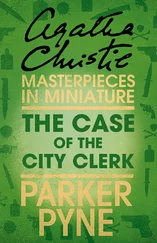Christopher Hibbert - Rome. The Biography of the City
Здесь есть возможность читать онлайн «Christopher Hibbert - Rome. The Biography of the City» весь текст электронной книги совершенно бесплатно (целиком полную версию без сокращений). В некоторых случаях можно слушать аудио, скачать через торрент в формате fb2 и присутствует краткое содержание. Жанр: Культурология, Искусство и Дизайн, на английском языке. Описание произведения, (предисловие) а так же отзывы посетителей доступны на портале библиотеки ЛибКат.
- Название:Rome. The Biography of the City
- Автор:
- Жанр:
- Год:неизвестен
- ISBN:нет данных
- Рейтинг книги:3 / 5. Голосов: 1
-
Избранное:Добавить в избранное
- Отзывы:
-
Ваша оценка:
- 60
- 1
- 2
- 3
- 4
- 5
Rome. The Biography of the City: краткое содержание, описание и аннотация
Предлагаем к чтению аннотацию, описание, краткое содержание или предисловие (зависит от того, что написал сам автор книги «Rome. The Biography of the City»). Если вы не нашли необходимую информацию о книге — напишите в комментариях, мы постараемся отыскать её.
Rome. The Biography of the City — читать онлайн бесплатно полную книгу (весь текст) целиком
Ниже представлен текст книги, разбитый по страницам. Система сохранения места последней прочитанной страницы, позволяет с удобством читать онлайн бесплатно книгу «Rome. The Biography of the City», без необходимости каждый раз заново искать на чём Вы остановились. Поставьте закладку, и сможете в любой момент перейти на страницу, на которой закончили чтение.
Интервал:
Закладка:
In the Capitoline temple of the god Jupiter, which this Flamen served, were kept the Sibylline Books, the Books of Fate, which contained the secret key to the destiny of Rome and which were, therefore, as awesomely regarded as the pronouncements of the Augurs. These Books of Fate, containing oracular utterances of the renowned Sibyl of Cumae, a Greek city in Campania, had been purchased and brought to Rome, so it was said, by Tarquinius Priscus. They were carefully guarded in the Temple of Jupiter where they were treated as sacred relics and consulted whenever important decisions were to be made. The texts they contained were framed in the vaguest terms and, as the sceptical Cicero complained, since all specific references to time and place were omitted, they could be interpreted as predicting anything that the Keeper of the Books wanted them to predict. His office, therefore, accorded him great political influence, and it was yet another one which the plebeians were determined to have opened to them.
From time to time the plebeians achieved a success in their struggle for political power. Not long after the promulgation of the Twelve Tables, for instance, in 445 B.C., the marriage of a plebeian with a patrician, forbidden by those laws, was allowed. In 348 B.C. it was agreed that one of the two Consuls should always be a plebeian; and in 338 that the Senate should automatically ratify all measures voted by the People's Assembly. Then, in 287 B.C., when a Dictator, Quintus Hortensius, was in temporary office at a time of national crisis, it was decreed that resolutions of the plebeians' Council should have the force of law without the need for the Senate's concurrence. This appeared a major triumph for the plebeians; but in practice it did not prove so, for not only were the leading and richer members of the plebeians' Council those least interested in upsetting the established regime, but the Tribunes of the People, the Council's guiding lights, were soon persuaded to be less enthusiastic in their support of plebeian rights by the grant of senatorial privileges. So the plebeians failed to take advantage of their victory; the patricians, looking down upon them as their social inferiors, continued to control the Senate, and the Senate controlled the government.
Throughout the struggle between the classes, Rome was gradually extending its dominion. Rival peoples in central Italy were defeated, including the Etruscans whose capital Veii, only ten miles from Rome, was utterly destroyed. Some of the vanquished were granted full Roman citizenship, others lesser privileges; the unmanageable were kept in subjection until they too were considered worthy of joining the growing federation of states. There was, however, a serious setback at the end of the fourth century B.C., when Gaulish nomadic tribesmen from beyond the Alps swarmed down into Italy. ‘Terrified townships rushed to arms as the avengers went roaring by,’ so Livy recounted. ‘The air was loud with the dreadful din of the fierce war-songs and discordant shouts of a people whose very life is wild adventure… Men fled from the fields for their lives; and from all the immense host, covering miles of ground with its straggling masses of horse and foot, the cry went up “To Rome”.’
North of the city the Roman army was routed, and the Gallic squadrons poured through the city's open gates. All men capable of bearing arms, so Livy said, together with the women and children and the more able-bodied Senators, had withdrawn to the fortress on the Capitol, leaving the aged and useless in the city below. With these remained the oldest of the patricians who, dressed in the ceremonial robes they had been privileged to wear in their days of office, sat waiting for death in the courtyards of their houses upon the ivory-inlaid chairs of the city's magistrates. Here the enemy found them.
They might have been statues in some holy place, and for a while the Gallic warriors stood entranced; then, on an impulse, one of them touched the beard of a certain Marcus Papirius – it was long, as was the fashion of those days – and the Roman struck him on the head with his ivory staff. That was the beginning: the barbarians flamed into anger and killed him, and the others were butchered where they sat. From that moment no mercy was shown; houses were ransacked and the empty shells set on fire.
In Rome today evidence of this conflagration can still be seen in the layer of burnt debris, fragments of roof-tiles and carbonized wood at the edge of the Forum.
The Capitol, however, was held against the Gauls. An assault was made upon it in daylight and driven off. Then one starlit night another attempt was made. The enemy clambered silently up the steep ascent, passing up their weapons from hand to hand. The guards heard nothing; even the dogs were silent.
But they could not elude the vigilance of the geese which, being sacred to Juno, had not been killed in spite of the shortage of provisions. The cackling of these birds and the flapping of their wings woke Marcus Manlius, consul of three years before and a distinguished soldier, who, catching up his weapons and at the same time calling the rest to arms, strode past his bewildered comrades to a Gaul who had already got a foothold on the crest and dislodged him with a blow from the boss of his shield. As he slipped and fell, he overturned those who were next to him, and the others in alarm let go their weapons and, grasping the rocks to which they were clinging, were slain by Manlius. And now the rest had come together and were assailing the invaders with javelins and stones, and presently the whole company lost their footing and were flung down headlong to destruction.
By this time provisions in the Gallic army were running low and disease was spreading fast as choking clouds of dust and ashes from the burned buildings blew across the camp. Corpses were piled in heaps and burned on a spot afterwards known as the Gallic Pyres. An armistice was arranged; and the surviving Gauls, anxious to return home to deal with enemies on their own frontiers, accepted a money payment and withdrew.
For Rome the experience had been both devastating and humiliating, and steps were soon taken to ensure that the city was better defended in future. In place of the rampart of Servius Tullius, a new wall of volcanic stone designed by Greek engineers was constructed to enclose an area of more than a thousand acres, including all the seven hills. 11From the gates in these walls, large parts of which can still be seen today, legions marched forth in campaign after campaign, against the Aequi, the Hernici and the Volsci, the Samnites, the Umbrians and the Gauls. All were eventually overcome and pacified, and thousands of foreign people were brought to Rome as slaves and many later set free. For the time being the south of Italy remained under Greek dominion; but by 265 B.C. Rome had become master of this area too, and was the supreme power in the Italian peninsula south of the Po.
Sicily, however, remained for the moment outside the sphere of Roman influence; and Rome's interest in this island led her into conflict with Carthage, the north African maritime power whose ships and armies controlled most of the western Mediterranean. The first war with the Carthaginians lasted for over twenty years, during which the Romans lost more than five hundred ships in storms and savage sea battles. But by a treaty of 241 B.C. Rome won control over most of Sicily and later took Sardinia and Corsica as well. A second war with Carthage began in 218 B.C. and brought fearful losses upon the Roman armies at the hands of the brilliant Carthaginian general, Hannibal, who marched across the Alps with his troops and elephants and inflicted defeat after defeat upon the legions, notably at Cannae in southern Italy where over thirty thousand Roman soldiers were killed. The disaster at Cannae was avenged on the Metaurus river where Hannibal's brother, Hasdrubal, was overwhelmed; but Hannibal himself remained undefeated in Italy where his hungry army wreaked havoc in the countryside. Handicapped by a lack of siege equipment, he did not attempt to capture the city of Rome, but on several occasions during the long war the Romans expected him to do so. Once he came within sight of the walls and pitched his camp only three miles away. The Romans, with grand defiance, put up his campsite for auction; and it fetched a high price. On another occasion, fears of an attack were increased by strange portents and by the discovery in unchastity of two Vestal Virgins, one of whom was buried alive in accordance with custom, while the other killed herself. The Sybilline Books were consulted, and by their direction a Gallic man and woman and a Greek man and woman were also buried alive in the market-place. At last, in the summer of 204 B.C., a strong Roman army under a brilliant young general, Publius Cornelius Scipio, sailed across the Mediterranean to Africa. Hannibal was recalled to meet the threat and two years later was decisively defeated at Zama, south-west of Carthage. Carthaginian power was thus destroyed, and in 146 B.C., to prevent it regaining its former dominion, Carthage itself was razed to the ground and its inhabitants massacred in accordance with the persistent demands of Cato who ended his every speech in the Senate, upon whatever subject it might be, with the words, ‘And I also think that Carthage must be destroyed.’
Читать дальшеИнтервал:
Закладка:
Похожие книги на «Rome. The Biography of the City»
Представляем Вашему вниманию похожие книги на «Rome. The Biography of the City» списком для выбора. Мы отобрали схожую по названию и смыслу литературу в надежде предоставить читателям больше вариантов отыскать новые, интересные, ещё непрочитанные произведения.
Обсуждение, отзывы о книге «Rome. The Biography of the City» и просто собственные мнения читателей. Оставьте ваши комментарии, напишите, что Вы думаете о произведении, его смысле или главных героях. Укажите что конкретно понравилось, а что нет, и почему Вы так считаете.












